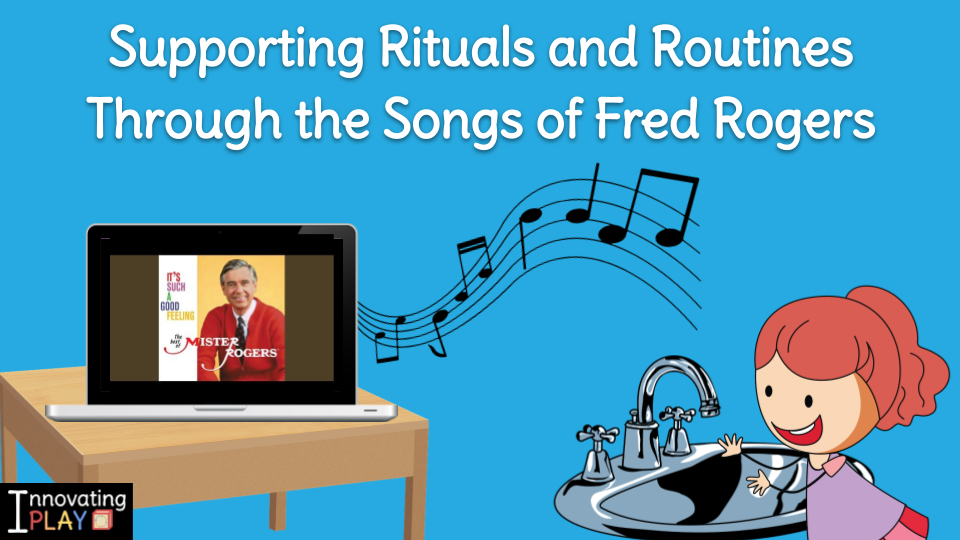
The mindset of Innovating Play was born from the idea that it is possible to protect and nurture best practices in early childhood education, while expanding opportunities for appropriate connection and discovery through technology. We are grounded in the belief that hands-on experiences and joyful learning can include everything from paint and blocks to Chromebooks and iPads. One of our most valuable resources to support and develop our work is the joint position statement focused on Technology and Interactive Media as Tools in Early Childhood Programs Serving Children from Birth through Age 8, developed by the Fred Rogers Center and the NAEYC. It is from our intentional work with this statement that we discovered an abundance of purposeful guidance and inspiration from The Fred Rogers Center and Mr. Rogers’ Neighborhood itself.
Connecting with the Educators’ Neighborhood
This year, I (Jessica) have the wonderful privilege of working as part of the Educators’ Neighborhood to closely study the work of Fred Rogers. As part of this cohort, we work to explore ways to directly integrate Mr. Rogers’ Neighborhood into daily practices with young children. Through this supportive community, we are encouraged to share our noticings, curiosities, approaches, and discoveries as they relate to our specific work with children.
Wondering with Mr. Rogers
Staying true to the purity of the work, I considered ways to elevate our approach to lesson design in Google Slides by integrating specifically selected songs from Mr. Rogers’ Neighborhood. I began with guiding questions to frame my curiosities and focus possibilities for practice:
- Which sources from Mr. Rogers’ Neighborhood are accessible and free so that they may be easily integrated into all classrooms, creating equity and opportunity for children and teachers?
- What can we learn about rituals and routines by closely noticing the intentional decisions that are made during an episode?
- How does the musical composition, lyrics, tone, and rhythm of a song contribute to the message of the show? How does this translate to a day in the classroom?
- In what ways can the use of intentional music throughout the day contribute to the culture of learning in the classroom?
- How can Google Slides provide a visual and auditory space that allows songs to be seamlessly accessed and connected to routines and rituals on a daily basis?
Playing with Songs, Rituals, & Routines
As I began to listen to each song, I took careful and specific notes on the details that I noticed. I considered the importance of repetition, musicality, and visual processing to establish the classroom culture. In order to easily bring the songs into our daily routines, I embedded the videos right into our daily Google Slide deck. I utilized the Theme Builder feature (located in the View menu) to design slide layouts. This allows me to seamlessly input information (such as morning messages) for each week and I do not need to redesign. I simply make a copy of my template every time I want a new deck.
In this slide deck you will find:
A Morning Message Space: We begin the message with the song, “Today is a Very Special Day.” During this simple song, children visually scan the message slide for clues about what might be happening during the day. Next to the video, I place an icon that reflects the daily special (related arts experience) they will be having. The song sets the tone for our togetherness, and immediately brings a sense of safety and comfort into the classroom. Just as Mr. Rogers would put on a fresh sweater and shoes, this is our time to settle into the routine of preparing for the day together.
Transitions: Moving between activities and shifting from one space to another can be overwhelming for children. As Mr. Rogers models throughout his episodes, creating a sense of safety and predictable rhythm within these types of routines can help children develop independence and executive functioning as they focus on the task at hand. In order to create a soft visual space and options for transitions, three songs were intentionally selected for this slide. The songs represent the tone of the transition, and support children in moving at a comfortable pace from one activity to the next. The times listed below the songs help to manage time by allowing up to six minutes to comfortably transition between activities. We have used this transition approach consistently to shift from recess back into the classroom. As children wash hands and settle back into a task that is waiting for them, the songs support a comfortable pace and allow time to readjust in order to be ready to learn.
Daily Closure: Creating a peaceful end to the day can be tricky as little ones are learning to independently pack up and navigate dismissal routines. Ending the day with a consistent reflection opportunity that highlights simple concepts that were covered, allows for meaningful closure. After reviewing the concepts, we use the song, “Tomorrow” in order to help children know that we will continue to provide a safe and joyful space for learning each day that we come back together.
Discovering through Practice
As we approach our fourth week in kindergarten, the flow of learning and culture of the classroom have taken shape. The songs of Fred Rogers are now seamlessly woven throughout our day. Evidence of the impact of the practice has been demonstrated through:
- Children’s voices joining in as the songs become familiar
- Calmness through movement, body language, and emotions demonstrated by the children as we move between tasks
- Families who have spent virtual learning time with us have shared specific comments such as, “It’s a Beautiful Day is now a song our family sings together!”
- Peaceful closure as children demonstrate independence and organization by packing up, reflecting together, and singing to close the day.
- The overall tone of the classroom is one of calmness, acceptance, and understanding of clear routines, procedures, and rituals that are in place
